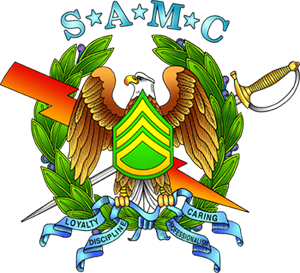
|
|
GRAPHICS AVAILABLE: Free to S.A.M.C. members (see links below). Businesses may use them too but a donation to the Foundation is recommended.
|
|
General Information:
The Sergeant Audie Murphy Club is a private U.S. Army organization for enlisted non-commissioned officers (NCO) only. Those NCO's whose leadership achievements and performance merit special recognition may possibly earn the reward of membership. Members must...
"...exemplify leadership characterized by personal concern for the needs, training, development, and welfare of Soldiers and concern for families of Soldiers (FORSCOM Reg. 600-8, paragraph 1)."
If an NCO meets these pre-requisites, the soldier may then be recommended by his non-commissioned officer chain-of-command to particiate in the rigorous board examination process.
The History:
The original club was started at Fort Hood, Texas early in 1986. There were several key people at Fort Hood - officer, enlisted, civil service, and a Killeen civilian - who were instrumental in getting this club up and running.
Leading the effort was Lieutenant General Crosbie Saint, then the III Corps commander; his Command Sergeant Major George L. Horvath; III Corps Awards Clerk Jean Crisp, and Don Moore, a Killeen artist who assisted with designing the logo and club awards.
In 1991, then III Corps Commander Lieutenant General Pete Taylor and Command Sergeant Major Richard B. Cayton expanded the Fort Hood installation club to include all of III Corps. This included Fort Riley, Kansas; Fort Sill, Oklahoma; Fort Bliss, Texas; Fort Polk, Louisiana; and Fort Carson, Colorado.
In 1993, CSM Cayton was voted into the Sergeant Audie Murphy Club by the membership and then became the Forces Command Sergeant Major. Soon thereafter, the club became Forces-Command (FORSCOM) wide, including the Reserves and National Guard.
In 1994 at a Sergeant Major of the Army conference, the Sergeant Audie Murphy Club spread Army-wide, to all commands with installations retaining the selection process for their own NCOs. In 1998, it was estimated that the club membership was over 3000 soldiers and was steadilly increasing.
The Crest's History:
The crest was designed by one of the original organizers of the club, Mr. Don Moore, a professional illustrator from Killeen, Texas. The digitized verctor graphic of the crest was drawn and colorized by the Foundation's webmaster with Mr. Moore's permission using a copy of the original sketch he personallly provided the Foundation.
Elements of the Crest:
The primary elements of the crest are ...
- The letters SAMC: an abbreviation for the "Sergeant Audie Murphy Club".
- The three stars: separate the letters and represent the "Be", "Know" and "Do" which is at the core of an Army NCO's professional spirit.
- The majestic American Bald Eagle: the national bird and our country's symbol for freedom. The eagle also represents the intent of the SAMC to be nationwide.
- The laurel: represents the individual achievement of the NCO in the club.
- The lightning bolt: represents swift and decisive action taken by the NCO.
- The sword is a historical reference and is the symbolic tool of the NCO to cut to the heart of the matter and to lead the charge.
- The U.S. Army staff sergeant stripes: represent the highest enlisted rank attained by Audie Murphy.
- The powder-blue streamers, the color of the infantry, indicate the words of the NCO philosophy: Loyalty, Caring, Discipline, and Professionalism.
|
The Motto: "You lead from the front."
... Audie Murphy
The Medallion:
When a soldier is inducted into the Sergeant Audie Murphy Club, he/she is given a formal medallion. The size of the medallion varies in these photos. The FORSCOM (Forces Command) version is silver and approximately 2.75 inches in diameter. The TRADOC (Training and Doctrine Command) version is bronze and is approximately 1.75 inches in diameter. The medallion is suspended by a broad powder-blue ribbon, approximately 18" in length folded. The ribbon's color represents the symbolic color of the infantry. The medallion is worn around the neck on the outside of the Class A or Dress Blue uniform for official functions such as military balls or Sergeant Audie Murphy Club meetings. Several examples of different unit medallions are shown below.
|
|
|
Front view, SAMC medallion, Camp Zama, US Army Japan. Photo source: SSG Jessie Alcala.
|
|
|
|
The US Army Japan SAMC medallion with ribbon. Photo source: SSG Jessie Alcala.
|
|
|
|
The FORSCOM (Forces Command) SAMC formal neck medallion with ribbon. Photo source: George Keck.
|
|
|
|
The FORSCOM (Forces Command) SAMC formal neck medallion, front view, without ribbon. Photo source: George Keck.
|
|
|
|
The FORSCOM (Forces Command) SAMC formal neck medallion, rear view, without ribbon. Photo source: George Keck.
|
|
|
|
The TRADOC (Forces Command) SAMC formal neck medallion, front view, without ribbon. Photo source: George Keck.
|
|
|
|
The TRADOC (Forces Command) SAMC formal neck medallion, rear view, without ribbon. Photo source: George Keck.
|
The Coin:
Sergeant Audie Murphy Club members often have coins engraved with the crest, the name of the chapter they were inducted in, or the name of the current chapter they belong to. Although the coin is not used by every chapter, it is commonly found with most. Those who have it show it with great pride. Those who don't have it usually wish they did.
|
|
|
This is the rear of a S.A.M.C. coin presented to SGT Boyden Elder, Fort Hood on the occassion of his induction to the S.A.M.C. Photo source: Boyden Elder
|
|
|
|
This is the front of a S.A.M.C. coin presented to SGT Boyden Elder, Fort Hood on the occassion of his induction to the S.A.M.C. Photo source: Boyden Elder
|
|



